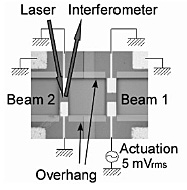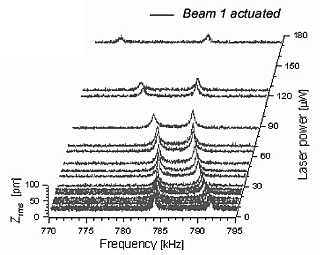Physical Science Laboratory
Coupled nanomechanical resonators have recently become the focus of research
because they allow the study of interesting physical phenomena, such as
synchronization and mode localization[1,2]. They also enable new applications
in sensors using the dynamics of the coupled system[3]. The coupling efficiency
is determined by the eigenfrequency difference in the resonators. Therefore,
frequency tuning is important and desired to control the vibrational coupling.
Here, we demonstrate the controlled coupling in nanomechanical resonators
by using photothermal stress. By this method, perfect vibrational coupling
was realized[4].
The nanomechanical system has two doubly-clamped beams of 40-µm
length, 10-µm width, and 0.8-µm thickness (Fig. 1). The beams
consist of top Au gates, AlGaAs/GaAs superlattice, n-GaAs, and i-GaAs layers. The two beams are mechanically coupled through an etching
overhang. Each beam can be actuated separately by the piezoelectric effect
by applying an a.c. voltage between the gate and the n-GaAs layer. The frequency response of the mechanical vibration was detected
using a He:Ne laser via optical interferometry (Fig. 1). The eigenfrequency
of the beams was tuned by adjusting the laser power. These measurements
were performed in a vacuum at room temperature.
Figure 2 shows the laser power dependence of the resonance spectra of
Beam 2 measured whilst actuating Beam 1. Two coupled vibrational modes
are found around the natural frequency: the nearly symmetric and anti-symmetric
vibration for the lower- and higher-frequency, respectively. The coupling
efficiency between the beams can be controlled by adjusting the laser power
(P). Photo-induced thermal stress modifies the eigenfrequency of the beam with changing its spring constant. Increasing P reduces the eigenfrequency difference between the two beams, therefore
enhancing the coupling efficiency. The frequency difference between the
two coupled modes decreases with increasing P and is minimized at P = 64 µW (Fig. 2). At this laser power, the coupling is maximized
and purely symmetric and anti-symmetric vibration is realized. For P > 64 µW, the frequency difference again increases with P increases, i.e., the coupled beams are optically detuned. The realization
of the perfectly tunable coupled nanomechanical resonators will offer the
opportunity for their high-sensitive sensing applications and for the study
of the dynamics of coupled systems.
[1] S. Shim et al., Science 316 (2007) 95.
[2] C. Pierre, J. Sound Vib. 139 (1990) 111.
[3] M. Spletzer et al., Appl. Phys. Lett. 88 (2006) 254102.
[4] H. Okamoto et al., Appl. Phys.Express 2 (2009) 062202.
 |
 |
|||||
|
|